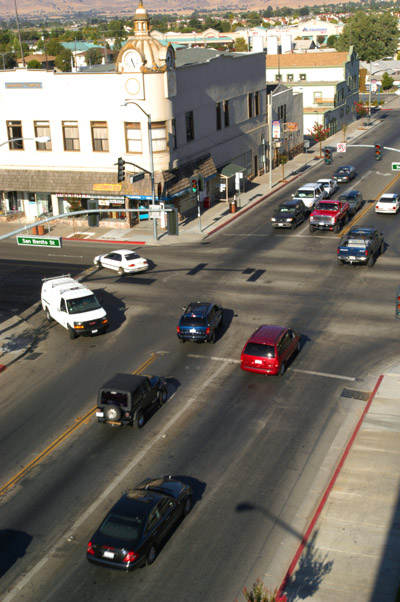
They’re incidents of frustration, reckless driving acts that
often endanger residential streets in Hollister, according to local
California Highway Patrol Capt. Bob Davies.
And in an effort to curb excessive speeding, accidents and other
acts of careless driving, a city hired firm on Monday presented an
outline of a long-awaited Neighborhood Traffic Management
Program.
They’re incidents of frustration, reckless driving acts that often endanger residential streets in Hollister, according to local California Highway Patrol Capt. Bob Davies.
And in an effort to curb excessive speeding, accidents and other acts of careless driving, a city hired firm on Monday presented an outline of a long-awaited Neighborhood Traffic Management Program.
The traffic calming study – as it was initially called during its inception 18 months ago – was compiled as a guide to direct the city to hazardous areas and streets that cause concern for residents.
The City Council contracted Gilroy-based Higgins and Associates in April 2002 for $18,000. At the time, the project was expected to last 90 days. To the dismay of Council members, however, it took 16 months to produce a final report. The Council is expected to approve the policy document at an upcoming meeting.
Barbara van Heerden, a Higgins and Associates engineer, defended the delay. The firm, she said, gave the report to city officials in January.
“So they’ve been sitting on it for months,” she said.
For the past few months, the Traffic Safety Advisory Committee has been reviewing the document and officials from several agencies within the county, including Davies, were part of the committee.
The policy document will address residential streets with traffic of more than 1,200 vehicles a day and strategies will be developed for each of the five Council districts. City officials also plan to hold neighborhood meetings to get feedback from residents.
“It’s the person passing on the right,” Davies said. “It’s the person who rolls through a stop sign or runs a red light. They get caught up in previous traffic and they’re making up for lost time.”
The report states that much of the increase in traffic problems has been caused by the city’s population growth during the past decades. According to the report, there have been 2,175 accidents in Hollister in the past 13 years and the annual number has increased from 345 in 1992 to 567 in 2001 – the final year of statistics included in the study.
Most people calling the city to complain throughout the years, according to Hollister engineers, have concerns about speeding on their streets. Since traffic engineer Matt Atteberry started in February, he has received 55 complaints, and most, he said, have been speeding related.
“This has been a pet peeve of mine,” said Councilman Tony LoBue regarding the city’s residential traffic problems, “because I get a ton of calls from people complaining.”
Three Council members listened to the presentation and afterward questioned van Heerden.
The report includes 26 pages of statistics, goals and strategies, along with six maps of targeted streets with the highest incidences of speeding and collisions. Information on locations of most frequent accidents from 1997 to 2001 was compiled by city staff and charted by the engineering firm.
The goals and objectives section of the report included basic intentions as “enhancing traffic safety in residential areas” and “Reduce speeds on residential streets without reducing safety.”
The city will use the document on a citizen-complaint basis. When residents express concerns to officials about a specific street, city staff members will evaluate that site.
Frequency of crashes, excessive speeding and school safety considerations were the top priorities for deciding whether to take action on a street, according to the report.
An increased law enforcement presence would be the first action taken. And if that fails, the city will consider alternative “devices” for traffic calming.
“Each individual problem will have to be studied on its own,” van Heerden said.
Strategies for less drastic issues include speed limit signs, speed monitoring trailers and stop signs.
“We can fit those in our operating budget,” said Public Works Director Clint Quilter.
Other strategies include pavement treatments, medians, traffic circles and raised intersections.
Quilter suggested the Council hold two meetings a year to decide which streets get approval for improved design work.
“You’re not going to have the money to make everybody happy,” he said.
Councilman Robert Scattini, who was elected after the program’s approval, said he “definitely would have voted against it.”
Scattini, also the county marshal, acknowledged an increase in speeding in recent years. But he said a “selective enforcement unit” approach, including added officers in target locations, would sufficiently slow drivers.
“Really, the big problem, honestly, is speeding,” Scattini said. “If we can correct that, I think we can win the battle.”









